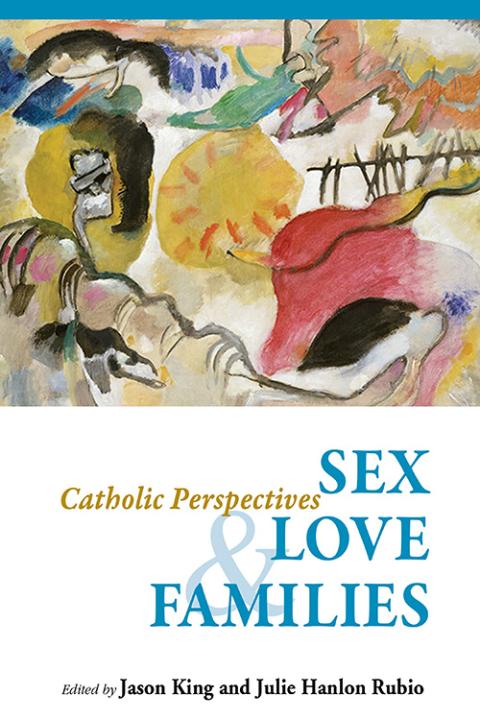
(Unsplash/Sean Foster)
In the recent discussions raised by San Diego Cardinal Robert McElroy on "radical inclusion," for LGBTQ people and others in the Catholic Church, one obstacle posed is the consistent teaching of the church in sexual ethics. As a moral theologian, I believe it is worth knowing how and why those teachings were formed in the first place. History helps us to see that underlying that "consistency" are a number of matters that convey an overriding negative estimation of human sexuality.
Christian moral teachings on sexuality evolved somewhat haphazardly over the centuries, with successive generations appropriating earlier positions that often had been based on very different premises. In general, a series of fairly negative accretions were added one upon another until, in the 17th century we have basically an absolutely negative estimation of sexual desires. Thus, with reason, historian James Brundage claims in Law, Sex, and Christian Society in Medieval Europe: "The Christian horror of sex has for centuries placed enormous strain on individual consciences and self-esteem in the Western world."
For the most part, the teachings derive from the concerns of celibate men who, while pursuing a life of holiness, found sexual desires to be obstacles rather than aids in that pursuit. These sexual desires were not understood as belonging to or needing to be included into a broader understanding of any particular dimension of human personality. Rather they were as random and as precipitous as they were for anyone who does not have an integrating concept like "sexuality." As arbitrary, powerful feelings, there was little about their nature that lent to their being conceptually incorporated into an overarching, integrated reality. The idea of these venereal desires was as unstable as the desires themselves were felt.
Language, too, hindered any tendency to understand these desires as belonging to something more integrated or holistic. In his The Bridling of Desire: Views of Sex in the Later Middle Ages, philosopher Pierre Payer reminds us:
A contemporary writer dealing with medieval ideas of sex faces a peculiar problem of language. Treatises entitled, "On sex," are nowhere to be found, nor does one find talk about "sexuality," because medieval Latin had no terms for the English words "sex" and "sexuality." In the strictest sense, there are no discussions of sex in the Middle Ages. … The concept of sex or sexuality as an integral dimension of human persons, as an object of concern, discourse, truth and knowledge, did not emerge until well after the Middle Ages.
Of course, the development of these teachings is so different from the positive language of the body that helped early theologians to continually articulate teachings on the resurrection of the body, the Incarnation and the Eucharist. As I argue in A History of Catholic Theological Ethics, our tradition on the human body expanded the depth and range of the Christian vocation. Indeed, whether we talked of the body, the family or the virtues, we considered each of them as gifts. Our tradition in those areas is indeed complex, but it is also rich, affirming and cogent.
The same cannot be said for the church's teachings on sex.

(Unsplash/Sandy Millar)
The tradition on sexual ethics led us not to greatness but to negativity and minutiae. Anything we added to the tradition only cast human sexuality as more and more negative. For instance, Paul's simple injunction that those who could not remain celibate should marry (1 Corinthians 7:8-9) led later to the Stoics' claim that marital intimacy needed to be validated not by the marriage, as Paul suggested, but by purposing the intimacy for procreation. That led later to Clement of Alexandria's judgment that sex for pleasure even in marriage was sinful. Why did we problematize marital love as we moved from Paul to Clement? Why did we need to validate marital love when Paul did not?

A likeness of St. Augustine is seen in stained glass at Caldwell Chapel on the campus of The Catholic University of America May 25, 2021, in Washington. (CNS/Tyler Orsburn)
Still, a look at the patristic period is not as problematic as later periods. In fact, Augustine's theology is less negative on matters of sex and marriage than both his contemporaries or worse, his 16th- to 19th-century successors. The negativity emerges more after than with Augustine.
For instance, we could examine the so-called consistent teaching on masturbation, which excepting Clement, was never assessed as a sin until John Cassian (360-435) and Caesarius of Arles (470-542) made it one, but only for monks and nuns who, violated their vows of chastity by masturbating.
Still, eight centuries later when Pope Innocent III imposed upon the entire church the Easter duty in 1215 requiring an annual confession of all Christians, sexual teachings change. Now masturbation is considered gravely sinful for all. The genesis of masturbation as sinful was precisely dependent upon the vow of chastity of those who chose the ascetical life. What was a sin for a 40-year-old monk in the eighth century became, however, the same sin for a 13-year-old boy or girl in the 13th century. Worse, as we will see, we made it a very grievous sin.
While there are many other topics, not least how the sexual experiences of women were assessed (or not), I propose three teachings that by building on each other bring the evolution of sexuality into an ambit completely defined as inevitably an occasion of sin. These teachings are known as "sins against nature," "intrinsic evil" and "parvity of matter."
Sins against nature were so named by St. Ivo, bishop of Chartres, as "always unlawful and beyond doubt more flagrant and shameful than to sin by a natural use in fornication or adultery." The sin was "to use the member for an illegitimate use."
In Contraception: A History of Its Treatment by the Catholic Theologians and Canonists, Judge John T. Noonan Jr., describes these language games: "There is never any attempt to provide a biological description of the acts condemned. Medical terms are eschewed. The vagina is usually described as 'the vessel' or 'the fit vessel.' Ejaculation is often described as 'pollution.' The term 'coitus interruptus' is never employed, but the usual description is 'outside the fit vessel'."
What links all these sins together is basically that the semen went elsewhere than the "fit vessel" and by going elsewhere the sin was "unnatural."
Advertisement
From Albert the Great and Thomas Aquinas until the 20th century, the moral treatises distinguished between sexual sins "in accordance with nature" and those "contrary to nature." While the former could include fornication, adultery, incest and even rape, in general the latter sins (solitary or mutual masturbation, contraception, anal or oral intercourse, bestiality) were considered more grievous, such was the obsession with the finality of semen and the "fit vessel." That masturbation was so long and consistently taught to be more grievous than rape might give us pause about the argument from consistency. And, it might also suggest how inadequately grievous rape was considered by the celibate theologians.
The sins against nature received further treatment by being coupled with two other conceptual categories: "intrinsic evil" and "parvity of matter." "Intrinsic evil" comes from the 14th-century Durandus of St. Pourcain (1270-1334), the anti-Thomist detractor. The term described a particular type of action as absolutely, always wrong regardless of circumstances. As I have written, this a priori evaluation removed from consideration any question of the moral legitimacy of such actions. They were described as such either because the action was against nature and/or the agent had no right to the exercise of such activity. All sexual acts against nature were now also classified as intrinsically evil. As intrinsically evil, all sexual acts against nature were now unequivocally exceptionless. No circumstance could mitigate their sinfulness.
In the 15th and 16th century some moralists began asking questions about lesser matters. They asked what was the moral quality of a kiss that aroused a person or a passing fantasy that was not repelled but, rather, allowed to stay, what they eventually called a "delectatio morosa." Were all these actions mortal sins? For some time, moral theologians were divided on this question.

(Unsplash/Elizabeth Tsung)
As theologian Jesuit Fr. Patrick Boyle reports in his Parvitas Materiae in Sexto in Contemporary Catholic Thought, in 1612 the superior general of the Society of Jesus, Claudio Acquaviva, condemned the position that excused from mortal sin any slight pleasure in venereal desires. Not only did he bind Jesuits to obey the teaching under pain of excommunication, he imposed on them the obligation to reveal the names of those Jesuits who violated even the spirit of the decree. As I have noted, these and other sanctions dissuaded moralists from entertaining any of the circumstantial exceptions as earlier casuists had.
By 1750 the moral manualists locked into place the teaching that all sexual desires and subsequent activity were always mortally sinful unless it was the conjugal action of spouses who assured that their "act" was in itself left open to procreation. Therein they assimilated into the tradition the claims that sins against the sixth and ninth commandments had no parvity of matter. Notably this position did not apply to any of the other commandments.
"Parvity of matter," "intrinsic evil" and the "sins against nature" combined to isolate venereal desires absolutely as such. In effect, just as the monk in the first millennium sought through ascetical practices to integrate himself body and soul but at the cost of dispensing with his own sexual desires, so too, in the second millennium after the imposition of the Easter duty, celibate church theologians managed to take away from the laity any sense of the legitimacy of sexual love and any sense that those desires could ever lead to anything good except under certain very clear conditions for procreative marital relations.
It is important to note that no other set of issues had such an unequivocal intolerance in the moral tradition, let alone such an elaborate set of linguistic concepts to "subdue" and condemn the activity. Even the prohibition against abortion allows certain indirect therapeutic exceptions (e.g., in the cases of women with a cancerous uterus or an ectopic pregnancy). And even then, there was never anything like the issue of "parvity of matter" that pursued people who considered an abortion or confessors who may have responded to questions about abortion without absolute severity.
It is important to note that no other set of issues had such an unequivocal intolerance in the moral tradition, let alone such an elaborate set of linguistic concepts to "subdue" and condemn the activity.
The other near absolute issue is lying. Yet, even though lying was named by Augustine as always in itself sinful, not everyone in the tradition at every time concurred, particularly on the matter of lying to protect the well-being of another. In fact, two distinctive trajectories of teaching on lying emerged. Only the teachings on sexual ethics were absolute, severe, extensive and without any exception.

The cover of the book "Sex, Love and Families: Catholic Perspectives," edited by Jason King and Julie Hanlon Rubio (CNS)
The Gospel summons to love and the early church's call to be one in mind and body developed well throughout the centuries but they never really influenced the church's later teachings on human sexual desires. In order for Christianity to advance, it did so by isolating and morally quarantining sex.
Until St. John Paul II introduced the "theology of the body," sex remained definitively the Catholic taboo. Now we can move on and take up where he left off, by articulating a theology of sexual ethics that sees sexuality as a gift and not a curse. But as we do, we might also consider the questions from Cardinal McElroy regarding the severity of these teachings that kept so many Catholics away from the sacraments and how we might begin a process of reconciliation for all those, who like ourselves are never worthy to approach the altar, but are by grace nonetheless invited.
Indeed, there are other signs that we are moving in the right direction, In Just Love: A Framework for Christian Sexual Ethics, ethicist Mercy Sr. Margaret Farley proposed a sexual ethics of love founded on justice. Though the Congregation for the Doctrine of the Faith issued a notification that it "risks grave harm for the faithful," it has become a staple in the writings of most theologians. More recently, the award-winning 25 essays in Julie Hanlon Rubio and Jason King's edited collection, Sex, Love, and Families: Catholic Perspectives provides a model for a responsible and loving sexual ethics.
A church that is trying to make itself right in the light of its record on sexual abuse needs to look not only at what it did and did not do, but also at its teachings that guided it in its judgments. Indeed, if anything is clear here, it is that the experiential wisdom of the laity needs to be fully engaged in the articulation of these much-needed teachings. Then, we may have a Christian life-giving, love-oriented sexual ethics worthy of its name.









